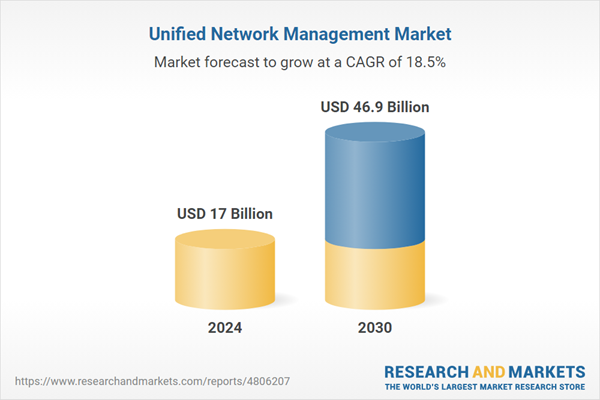Global Unified Network Management Market - Key Trends & Drivers Summarized
Why Is Unified Network Management Becoming Increasingly Important?
Unified Network Management is becoming increasingly important for organizations as the complexity of network environments continues to grow. With the proliferation of cloud services, mobile devices, IoT, and remote work, managing and securing a network has become more challenging than ever. Unified Network Management solutions provide a centralized approach to managing all aspects of a network, including monitoring, security, and performance optimization. This comprehensive visibility and control are essential for ensuring network reliability, preventing security breaches, and supporting the seamless operation of business-critical applications. The growing need for efficient and effective network management in today’s interconnected world is a key factor driving the adoption of unified network management solutions.What Technological Advancements Are Shaping The Unified Network Management Market?
The unified network management market is being shaped by several technological advancements that are enhancing the capabilities of these solutions. The integration of artificial intelligence (AI) and machine learning (ML) into network management platforms is enabling more sophisticated network analytics, predictive maintenance, and automated problem resolution. These technologies are helping organizations to proactively manage their networks, identify potential issues before they impact performance, and optimize network resources. The development of cloud-based network management solutions is another key trend, providing greater scalability, flexibility, and ease of deployment, especially for organizations with distributed networks. Additionally, advancements in network security, including the integration of advanced threat detection and response capabilities, are making unified network management solutions more robust and essential for protecting against increasingly sophisticated cyber threats.Which Industries Are Leading The Adoption Of Unified Network Management?
The adoption of unified network management solutions is particularly strong in industries that require high levels of network reliability, security, and performance. The telecommunications industry is a leading adopter, using these solutions to manage complex, high-capacity networks that support voice, data, and video services. The financial services sector is another significant user, where unified network management is critical for ensuring the security and performance of networks that handle sensitive financial data and support online banking and trading platforms. The healthcare industry also relies heavily on unified network management to secure and manage networks that support electronic health records (EHR) systems, telemedicine services, and other critical healthcare applications. The education sector, particularly universities and large educational institutions, is increasingly adopting unified network management to manage campus-wide networks and support online learning platforms. Additionally, the rise of remote work and the increasing reliance on cloud services across various industries are driving demand for unified network management, as organizations seek to manage and secure their networks in a rapidly evolving digital landscape.What Factors Are Driving Growth In The Unified Network Management Market?
The growth in the unified network management market is driven by several factors, including the increasing complexity of network environments and the need for comprehensive visibility and control. The rise of cloud computing, IoT, and mobile devices is a significant driver, as these technologies are making network management more challenging and creating a greater need for centralized management solutions. The growing threat of cyberattacks and the need for robust network security are also fueling market growth, as unified network management solutions provide the necessary tools to monitor and protect networks from a wide range of threats. Additionally, the trend towards remote work and the increasing use of cloud services are driving demand for unified network management, as organizations need to ensure the reliability, security, and performance of their networks in a distributed and dynamic environment. The ongoing advancements in network management technologies, including AI-driven analytics, cloud-based solutions, and integrated security features, are further contributing to the growth of this market, making unified network management an essential tool for organizations of all sizes and industries.Report Scope
The report analyzes the Unified Network Management market, presented in terms of units. The analysis covers the key segments and geographic regions outlined below.Segments: Solution (Network Monitoring Management, Network Performance Management, Network Security Management, Network Configuration Management, Network Application Management); Deployment (On-Premise Deployment, Cloud); Vertical (IT & Telecom, BFSI, Retail & Consumer Goods, Travel & Hospitality, Healthcare, Government, Other Verticals).
Geographic Regions/Countries: World; United States; Canada; Japan; China; Europe (France; Germany; Italy; United Kingdom; and Rest of Europe); Asia-Pacific; Rest of World.
Key Insights:
- Market Growth: Understand the significant growth trajectory of the Network Monitoring Management segment, which is expected to reach US$20.7 Billion by 2030 with a CAGR of a 19.5%. The Network Performance Management segment is also set to grow at 18.1% CAGR over the analysis period.
- Regional Analysis: Gain insights into the U.S. market, valued at $4.7 Billion in 2024, and China, forecasted to grow at an impressive 17.2% CAGR to reach $6.9 Billion by 2030. Discover growth trends in other key regions, including Japan, Canada, Germany, and the Asia-Pacific.
Why You Should Buy This Report:
- Detailed Market Analysis: Access a thorough analysis of the Global Unified Network Management Market, covering all major geographic regions and market segments.
- Competitive Insights: Get an overview of the competitive landscape, including the market presence of major players across different geographies.
- Future Trends and Drivers: Understand the key trends and drivers shaping the future of the Global Unified Network Management Market.
- Actionable Insights: Benefit from actionable insights that can help you identify new revenue opportunities and make strategic business decisions.
Key Questions Answered:
- How is the Global Unified Network Management Market expected to evolve by 2030?
- What are the main drivers and restraints affecting the market?
- Which market segments will grow the most over the forecast period?
- How will market shares for different regions and segments change by 2030?
- Who are the leading players in the market, and what are their prospects?
Report Features:
- Comprehensive Market Data: Independent analysis of annual sales and market forecasts in US$ Million from 2024 to 2030.
- In-Depth Regional Analysis: Detailed insights into key markets, including the U.S., China, Japan, Canada, Europe, Asia-Pacific, Latin America, Middle East, and Africa.
- Company Profiles: Coverage of players such as Alcatel-Lucent SA, Avaya, Inc., CA Technologies, Inc., Cisco Systems, Inc., Dell EMC and more.
- Complimentary Updates: Receive free report updates for one year to keep you informed of the latest market developments.
Some of the 46 companies featured in this Unified Network Management market report include:
- Alcatel-Lucent SA
- Avaya, Inc.
- CA Technologies, Inc.
- Cisco Systems, Inc.
- Dell EMC
- Ericsson AB
- Hewlett-Packard Development Company LP
- Huawei Technologies Co., Ltd.
- IBM Corporation
- Juniper Networks, Inc.
Tariff Impact Analysis: Key Insights for 2025
Global tariff negotiations across 180+ countries are reshaping supply chains, costs, and competitiveness. This report reflects the latest developments as of April 2025 and incorporates forward-looking insights into the market outlook.The analysts continuously track trade developments worldwide, drawing insights from leading global economists and over 200 industry and policy institutions, including think tanks, trade organizations, and national economic advisory bodies. This intelligence is integrated into forecasting models to provide timely, data-driven analysis of emerging risks and opportunities.
What’s Included in This Edition:
- Tariff-adjusted market forecasts by region and segment
- Analysis of cost and supply chain implications by sourcing and trade exposure
- Strategic insights into geographic shifts
Buyers receive a free July 2025 update with:
- Finalized tariff impacts and new trade agreement effects
- Updated projections reflecting global sourcing and cost shifts
- Expanded country-specific coverage across the industry
Table of Contents
Companies Mentioned (Partial List)
A selection of companies mentioned in this report includes, but is not limited to:
- Alcatel-Lucent SA
- Avaya, Inc.
- CA Technologies, Inc.
- Cisco Systems, Inc.
- Dell EMC
- Ericsson AB
- Hewlett-Packard Development Company LP
- Huawei Technologies Co., Ltd.
- IBM Corporation
- Juniper Networks, Inc.
Table Information
| Report Attribute | Details |
|---|---|
| No. of Pages | 196 |
| Published | April 2025 |
| Forecast Period | 2024 - 2030 |
| Estimated Market Value ( USD | $ 17 Billion |
| Forecasted Market Value ( USD | $ 46.9 Billion |
| Compound Annual Growth Rate | 18.5% |
| Regions Covered | Global |









